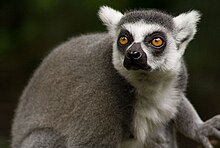Lemuridae
| Lemuridae | |
|---|---|
 |
|
| Ring-tailed lemur (Lemur catta) | |
| Scientific classification | |
| Kingdom: | Animalia |
| Phylum: | Chordata |
| Class: | Mammalia |
| Order: | Primates |
| Suborder: | Strepsirrhini |
| Superfamily: | Lemuroidea |
| Family: |
Lemuridae Gray, 1821 |
| Type genus | |
|
Lemur |
|
| Genera | |
Lemur
Eulemur
Hapalemur
Prolemur
Varecia
Lemuridae is a family of strepsirrhine primates native to Madagascar, and the Comoros Islands. They are represented by the Lemuriformes in Madagascar with one of the highest concentration of the lemurs. One of five families commonly known as lemurs. These animals were once thought to be the evolutionary predecessors of monkeys and apes, but this is no longer considered correct.
Lemurids are medium-sized arboreal primates, ranging from 32 to 56 cm in length, excluding the tail, and weighing from 0.7 to 5 kg. They have long, bushy tails and soft, woolly fur of varying coloration. The hindlegs are slightly longer than the forelegs, although not enough to hamper fully quadrupedal movement (unlike the sportive lemurs). Most species are highly agile, and regularly leap several metres between trees. They have a good sense of smell and binocular vision. Unlike most other lemurs, all but one species of lemurid (the ring-tailed lemur) lack a tapetum lucidum, a reflective layer in the eye that improves night vision. Historically, activity cycles are either strictly diurnal or nocturnal however, these can widely verily across the mammalian species. Lemur activity has evolved from nocturnal to diurnal. Some lemurs are also cathemeral, an activity pattern here an animal is neither diurnal nor nocturnal, which is common among Lemurdae.
Lemurids are herbivorous, eating fruit, leaves, and, in some cases, nectar. For the most part, they have the dental formula: 2.1.3.32.1.3.3. A lemur’s diet is one that is not restricted since their diet consists of frugivory, granivory, folivory, insectivory, omnivory, and gumnivory foods. Some Subfossil records have contributed to the knowledge of the currently extant lemurs from the Holocene by showing the changes in their dental records in habitats near human activity. This demonstrates that lemur species such as the lemur catta and the common brown lemur were forced to switch their primary diet to a group of secondly food sources.
...
Wikipedia
